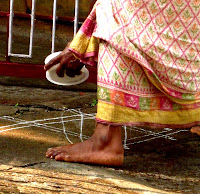
Estamos a chegar a mais um final de ano e com toda a certeza que este próximo 2012, será muito exigente, espero que a vossa prática de Ashtanga Yoga, sirva de animo, inspiração e motivação, para terem a confiança, a energia e a "garra" para superarem qualquer obstáculo que apareça no vosso caminho.
Se há coisa que esta prática ensina é que "(...) We might observer our tendency to overcompensate, or the inability of our mind to stay focused on the posture, or the tendency of our breath to become shallow or disconnected. The specifics of our observation are less important that the fact that we learn to stay on the task, observing-correcting, observing-correcting, using technique and countertechnique, and then letting them go to be there for whatever is presenting itself without the distractions of concluding, projecting, accepting or rejecting. Observing our body as the field of the practice, we gradually begin to see interrelated processes and patterns within the mind, the body, and the breath as they occur, and this allow us to fall into a very deep state of meditation". Richard Freeman, "The mirror of Yoga - Awakening the Intelligence of Body and Mind", Shambala Publication, Inc., 2010
Começamos todos por aprender a respirar, uma respiração estável e ritmada, que permita entrar, permanecer e sair de cada postura (vinyasa) com a mente atenta e focada, posteriormente vamos conhecendo a correcta forma de executar as posições, assim como os drishtis e os bandhas. Desenvolvemos as técnicas do Ashtanga Yoga, delineado por Shri K. Pattabhi Jois (1915-2009) e percebemos que estas são meros veículos para a concentração, consciência e observação, primeiro dos padrões da nossa respiração, depois do nosso corpo e da nossa mente.
Somos gradualmente levados para a vivência do presente, sentimos realmente a nossa inspiração e a nossa expiração, o esticar do braço esquerdo, o levantar da perna, o dobrar para trás, reconhecemos um corpo, o nosso corpo, reparamos como funciona o processo de identificarmos, catalogarmos, analisarmos, projectarmos. Traçamos teorias e conclusões, distinguimos bom do mau, fácil do difícil, ágil do pesado, todo um mundo de oscilações que nascem e são perpetuadas pela nossa mente, opostos que influenciam a nossa forma de pensar e agir.
Esta prática utiliza o corpo como meio concreto de sentirmos e observarmos o poder da nossa mente, de cruzarmos análises face aos nossos vrttis (oscilações da mente) e samskaras (padrões de pensar, sentir e agir), de traçarmos teorias sobre como executarmos as posturas, como respirarmos nestas, de verificarmos como unimos objecto, pensamento e emoção, mas chega a uma altura que temos de largar todos estes conhecimentos, largar o 1% de teoria e saborearmos os 99% de prática, raízes fortes para simplesmente estarmos, para sermos, respiração, corpo e mente, para sermos um e sem distinções de opostos, sem caracterizações ou monólogos mentais e emocionais, vivemos uma prática e uma vida, onde existimos plenamente.
Aprendemos a estar em nós mesmos, a estar no momento, a mantermos-nos na "tarefa" até ao fim, aumentamos os conhecimentos sobre nós mesmos, a nossa confiança e crença, o nosso discernimento e "garra" para ultrapassamos as dificuldades no tapete e fora deste. Aprendemos a estar na "task", a estar presentes.



















